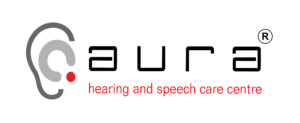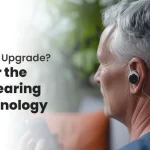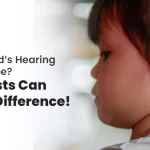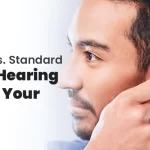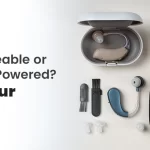
Choosing the right hearing aid can feel overwhelming—especially with so many options available. Whether you’re a senior experiencing age-related hearing loss or a young adult impacted by loud music or workplace noise, the right hearing aid can drastically improve your quality of life.
Before making a purchase, it’s crucial to understand what type of hearing loss you have. From Behind-the-Ear (BTE) models to Invisible-In-Canal (IIC) devices, there’s a hearing solution tailored to every lifestyle. In this guide, we’ll help you understand different types of hearing loss, explore hearing aid styles, and identify the features that matter most—so you can choose with confidence.
Understanding Hearing Loss Types
Knowing your hearing loss type helps narrow down your options. Here’s a quick breakdown:
-
Presbycusis (Age-Related Hearing Loss)
A common condition for adults over 60, presbycusis affects the ability to hear high-pitched sounds and worsens gradually over time. Learn more about Sensorineural Hearing Loss Causes.
-
Noise-Induced Hearing Loss
Often affecting younger adults exposed to high-volume environments—like concerts, factory floors, or frequent headphone use—this type can make speech hard to understand. Related read: Can Tinnitus Cause Hearing Loss?
-
Conductive Hearing Loss
Caused by physical blockages or ear infections that prevent sound from reaching the inner ear. Hearing aids can be helpful in many cases, but treatment depends on the cause. Explore:
Sensorineural Hearing Loss
This occurs when the auditory nerve or inner ear is damaged. It may require advanced digital hearing aids.
Check out our blog on Different Types of Hearing Loss and Their Causes for a complete overview.
Types of Hearing Aids
Choosing the right style depends on your hearing condition, lifestyle, and cosmetic preferences:
-
Behind-the-Ear (BTE)
- Suitable for all degrees of hearing loss
- Durable and easy to handle
-
In-the-Ear (ITE)
- Custom-molded
- Ideal for mild to moderate hearing loss
-
In-the-Canal (ITC) and Completely-in-the-Canal (CIC)
- Discreet, fits inside the canalGreat for people who prefer near-invisible options
-
Receiver-in-Canal (RIC)
- Smaller than BTE
- Better sound quality with less feedback
Key Features to Look For
✅ Rechargeable Batteries
- Forget constantly replacing batteries—just dock your device overnight.
✅ Bluetooth Connectivity
- Stream calls and music directly to your hearing aids. Ideal for younger users or professionals.
✅ Noise Reduction
Filters out background noise for clearer conversations, especially in busy environments.
For people experiencing tinnitus, check out:
Consulting an Audiologist
Why Do You Need to Consult an Audiologist ?
No two ears are the same. A certified audiologist will perform a professional hearing test to determine the type and severity of your hearing loss and help you select the best-fit device.
Tailored Recommendations
Whether you’re active or homebound, your audiologist will suggest hearing aids that match your lifestyle, budget, and tech preferences.
Conclusion
Choosing a hearing aid isn’t just about what looks good or costs less—it’s about selecting a device that aligns with your hearing profile and daily needs. Whether you’re a senior adjusting to hearing changes or a younger adult coping with noise damage, the right hearing aid can help you reconnect with the world around you.
👂 Ready to take the first step? Book an Appointment | Expert Hearing Care Consultation today and discover your ideal hearing solution.
1. How do I choose which hearing aid is right for me?
Start with a hearing test from a certified audiologist. They’ll recommend the best model based on your hearing loss type and lifestyle.
2. Are all hearing aids visible?
No, Many models, such as Invisible-In-Canal (IIC) hearing aids, are almost invisible and sit deep in the ear canal.
3. Do I need two hearing aids or just one?
If you have hearing loss in both ears, using two aids offers better clarity and directional hearing.
4. How long do hearing aids last?
Most hearing aids last 3 to 7 years, depending on use and maintenance.
5. Can hearing aids improve my hearing completely?
While hearing aids don’t cure hearing loss, they greatly enhance sound clarity and communication ability.

